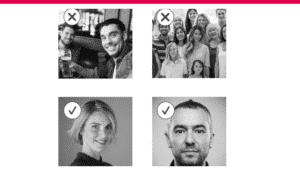
by Annette Burgard | Jan 3, 2019 | Worker resources
January can be tough on your mood—and your wallet. The festivities are over, but the year is just beginning. You might be asking yourself, “How can I start the year off right when I’ve spent everything in December?” Making a budget is usually the go-to idea, but hard to implement: budgets don’t always work, they can be hard to estimate, and they can be quite stressful as well. After all, who wants to constantly think about saving money all the time? Luckily, Coople has some tips that can help you save up and lighten the weight of January.
1. Use the 24-hour rule
This tip is easy because it requires you to do only one thing: wait. It works like this: imagine you come across the perfect spring jacket. Before you hit the checkout counter, wait at least 24 hours. Sleeping on a purchasing decision overnight creates distance from the excitement of buying something new. By the next day, you’ll be in a better state to make rational decisions and to ask yourself questions like, “Do I really need that jacket?”
2. Think temporal
Instead of focusing on how expensive or cheap an item is, try converting your cost into hours worked: take the price of whatever you want to buy and divide it by your average hourly wage. So for example, if your jacket costs CHF 500.- and you make CHF 25.- an hour: is the jacket worth 20 hours (or half a week) of work?
3. Remove the temptation
This may sound like an unconventional tip, but it really works, especially if you like to shop online. Remove the temptation of new year sales by unsubscribing from mailing lists from the stores you spend the most money on. It’ll give you greater peace of mind as you’ll see fewer advertisements urging you to spend money. Plus, you can always resubscribe at a later time if you want.
4. Drink water
Have you realized that your Coke Zero costs more in a restaurant than when you buy it from the grocery store? Beverages are priced high relative to their cost, and it’s the one thing that you can definitely save on when eating out. In fact, try committing to eating less often at restaurants if it’s a habit: you can save a lot by cooking at home and shopping for discounted items. And when you do eat out, make sure to stick to tap water!
5. Work with Coople
To give your savings a soaring start in 2019, pick up an extra shift or two with Coople! Whether you’re looking for office work or prefer the bustling buzz of a restaurant, you’re sure to find a job that suits your liking. Take a look at our job board or set your availability and location in Coople and let jobs come to you. Learn more »
So while January may be gray and gloomy, it is also the perfect opportunity to cut costs, embrace a more minimalistic mindset, and focus on your goals and resolutions.

by Annette Burgard | Sep 17, 2018 | Worker resources
Alright, so you’ve refined your CV and also have a great headshot ready to go. What’s next? If you haven’t completed your Coople Profile, make sure to check out our quick how-to with tips and tricks on optimizing your profile. Once you’ve completed that, it’s time to get to work! In this blog post, we’ll show you the tips and tricks you need to make finding jobs on Coople a breeze.
As you may no doubt come to realize, there are plenty of opportunities waiting for you on Coople. However, if you want to spend less time searching and go straight to finding the perfect mission for you, there are several things you can do to narrow down your search. The top 3 things we recommend doing to facilitate your job search is setting your availability, geographic location, and any salary expectations you may have in Coople.
What is the perfect Coople job?
1. Work whenever you want
Life can get unpredictably busy, so whatever your schedule looks like, let employers know your general availability in Coople with a simple yes or no selection. This also ensures you won’t be notified about jobs during periods when you’re not able to work.
DID YOU KNOW? You have a calendar that you can personalise in your Coople account. Use it to your advantage: if you know you won’t be available to work during a certain time, you can “Enter an Absence” in your calendar. This creates a block in your calendar and you will not be contacted for jobs taking place during this period.
2. Work wherever you want
Aside from setting your availability to work, you also have the option to narrow down your job hunt by location. The easiest way to do this is in the new Coople app on your phone. Whether you want to filter your results by location or set the radius for your job search, the interactive map feature is your go-to feature. It’s never been easier to have control over where you want to work.
3. Work as you want
Aside from having the freedom to set your own working hours and location, you can filter your job searches further. From the Coople app, it’s possible to set your own minimum wage as well as define a range for how much you want to work.
With these tips in hand, you’re all set. Now you can sit back, relax, and wait for the perfect jobs to come to you. One you find a job you like, just hit the apply button—it’s that easy! We wish you all the best on your job search. For more work-related tips, tricks, and stories, be sure to follow our blog.

by Annette Burgard | Sep 17, 2018 | Worker resources
If your goal is to get hired, then good news: you’ve come to the right place! In this blog post, we’ll show you how to write a great CV that will increase your chances of getting hired. (On a related note, if you also are in need of a new profile picture, check out our blog post with tips on how to take the best profile pic). Plus, you’ll also find a Coople-approved CV template to use for your applications!
So how does an effective CV look like? What should you do and what shouldn’t you do? What’s the best structure to highlight your skills? Below are the Coople team’s top 3 tips for structuring, designing, and writing the CV that will get you the job you want.
1. Structure your CV strategically
Your potential future employer needs to see the most relevant information to the mission. Often, recruiters and managers review dozens of CVs a day, and they don’t have the time to do a deep dive into every application they receive. To make sure your application stands out, your CV should help them find what they’re looking for—as quickly as possible. In other words, if they only have 20 seconds to look at your CV, what are the things you want them to see?
PRO TIP: Effective CVs often contain the following categories:
- Personal information: name, date of birth, nationality, address, contact details
- Personal experience: job title, company name, tenure, company location, detailed responsibilities and projects
- Educational background: degrees earned, school name, years of study, school location, training received
- Languages spoken: What languages can you work in and how well do you speak them? (Check out the CEFR for an easy way to document your language skills.)
- Hard skills (or IT skills): Have you had any training or certifications in software? Do you know your way around a cash register? Do you have a driver’s license? Make sure to mention them on your CV.
- Soft skills (or other skills): Are you a team player, communicative, or pay attention to detail? List them as well, because they say a lot about your working style.
- Hobbies: Put interests that may be related to your work first. (For example, “photography” is a relevant hobby if you are applying for a marketing job.)
2. Make your words count
Writing a CV is hard work, and you may have many things you would like to show your employers. But keep in mind that the person looking at your CV may not have time to look at every little detail. They just need to know enough information to decide whether or not they would like to invite you for an interview. The interview is where you’ll have the opportunity to impress, dazzle, and show off your personality. With that said, we recommend keeping your CV to a two-paged PDF on A4-sized paper.
PRO TIP: Use the same keywords that your future potential employers used in the job description. The more matching keywords, the more chances your CV has of making it into the “maybe yes” pile!
3. Get your CV checked
There’s nothing worse than spending so much time and effort on your CV only to send it off and then spot a mistake. Not only can this make a bad first impression, it is something that can easily be avoided. Find someone you trust and ask that person to review your CV. If you can’t find anyone, then upload your CV text to a spell-checker or online tool like Grammarly.
PRO TIP: Try to ask someone with a different professional background than you to check your CV. This person can provide you with more objective feedback and show you tips and tricks you may not have been aware of.
Bonus Tip: Download Coople’s CV template
To help you get started, we’ve created a Coople-approved CV template for you to use on your job applications. You can get it here for free. In addition to the template, be sure to also check out our how-to guide on creating your best profile in Coople.

by Annette Burgard | Sep 17, 2018 | Worker resources
It probably comes as no surprise that you can increase your chances of getting hired with the right profile picture. While the customs for including headshots in your job application will differ depending on your country, in Switzerland as well as many parts of Europe, it is generally recommended to include a photo of yourself in your CV. (You can learn more about best CV practices here .) In other places like America, where equal employment regulations are much stricter, profile pictures are not included in job applications.
Nevertheless, your profile picture is a good way to establish your own personal, recognizable brand, and for this reason, we recommend completing your Coople profile with a picture of yourself. But before you upload just any picture, there are some general guidelines you should be aware of when it comes to CV and job profile etiquette. Below are our 3 tips for taking your best profile picture.
1. Avoid selfies, even if it’s a great one
While you may think that your best photos are often taken by yourself, there’s a time and a place for everything. Selfies (and face filters) don’t convey that you’re serious about finding a job. Employers don’t need to see your best angle; they want to see someone they can imagine employing in their restaurant, hotel, or office.
See some good and bad examples below:

2. Take the center stage of your picture
Contrary to popular belief, you also don’t need a fancy camera to take a good headshot. Great profile pictures can be deceptively simple to create, and they don’t require an amazing backdrop or any fancy colors. If you don’t know where to start, ask a friend or a parent to take a snapshot (or several) of you using their phone or camera against a neutral or white background. Once done, use the editing feature in your phone, a photo-editing app, or a software like Photoshop to adjust the brightness, contrast, and warmth of your photo to your liking.
PRO TIP: For a better portrait, leave some distance between you and the wall to let the lens focus on you.
3. Say cheese!
You’re not taking a super-serious picture for your passport or ID, so feel free to showcase your personality with a smile if you want. If you find it difficult to hold a smile or a pose, ask your photographer to take a burst of snapshots as you move from one pose to another. The camera will capture your face in motion, resulting in a more natural-looking photo. Your headshot on your Coople profile should reflect your personality and let your potential future employer know that you’re the right hire.
DID YOU KNOW? 90% of all employed Cooplers have a picture of themselves on their Coople profile, and it’s proven that having a profile picture will boost your chances of getting hired for a mission . You also have the option of uploading more than just one picture, so you can show employers you are suited to a wide range of roles.

by Annette Burgard | Sep 17, 2018 | Worker resources
Completing your Coople profile is as easy as 1-2-3, and it’s one of the best ways to get noticed by employers. In this post, we’ll guide you through the steps to fill out your profile on Coople. If you haven’t done so already, take a look at our other blog posts for tips and tricks on creating a CV and taking a great profile picture.
1. First things first
In order to make sure potential employers can reach you and that you are properly paid for your work, you should update your Coople profile with the following information:
- Your contact details: email, telephone, address
- Your bank details, namely your IBAN number
- Any work-related documents, such as a copy of your work permit, passport, and AHV number
DID YOU KNOW? Before you can be hired for a job, Coople must verify your right to work, a process that may take up to a couple of days. This is why we recommend updating your Coople profile with the above information as soon as possible!
2. Get to know Coople job profiles
One of the perks about signing up to Coople is that you don’t have to get stuck with doing the same job every day. Depending on your education and previous work history, you may select different job profiles across a variety of industries, such as Event Assistant, Chef, or Insurance, just to name a few.
You can add up to 10 different job profiles in your Coople account. The more job profiles you select, the more diversified the missions you receive will be, potentially widening your chances of getting hired for a job.
TIP: Some job profiles require additional documentation of your education or skills, so make sure to read each profile description carefully and upload your the documents when asked.
3. Create a short profile summary
Another great way to catch a future employer’s attention is to write a couple of sentences about yourself in the about me section of your Coople profile. Introduce yourself in a few sentences and let employers know how you work and what you’re looking for professionally. A good example of a profile summary can be:
I am a bilingual (German and Italian) professional currently pursuing a degree in Economics at the University of Zurich. As a student, I am primarily looking for temporary and flexible jobs in the hospitality and gastronomy industries as well as office work related to my field of study. However, I am also open for other work opportunities as well!
In this example, you’re letting any future employers know your language skills, industries of interest, as well as the type of jobs you are looking for. However, you’re also leaving room open for other opportunities which could be interesting.
And voilà, your profile is now complete! The job marketplace is waiting for you, so go ahead and check it out. If you need some help along the way, check out our blog post on how to find a job that suits your profile.





